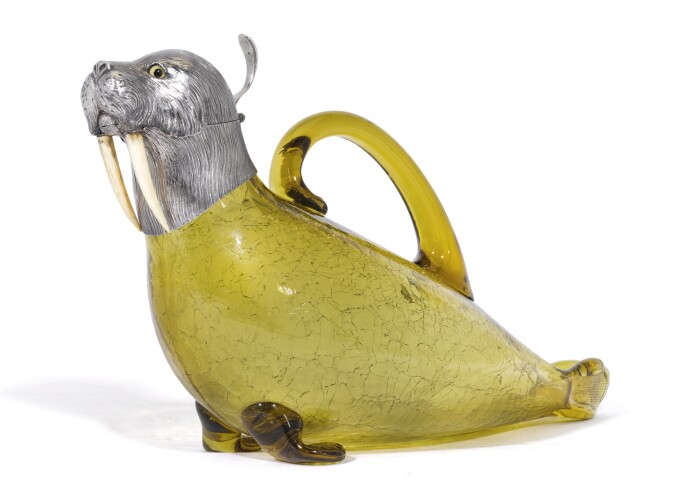T his Victorian novelty claret jug was consigned after a routine enquiry to the online request an estimate service. Marked "Alexander Crichton 1881" it attracted interest from both collectors of claret jugs and collectors of Victorian novelty silver.
The seller inherited it from his grand-mother Margaret Eva Martin. Born in 1899 and a daughter of a Gloucestershire village school headmaster she was an optician practising in Leeds and in the 1950’s moved to St Peter Port, Guernsey, at which point she passed the seal to the seller’s parents who were getting married and furnishing their first home. How Margaret obtained the seal is not known but she was a keen enthusiast of auctions and antique shops and the seller clearly remembers as a child being allowed to view it but not touch it!
In St Peter Port, Margaret was well-liked and renowned for helping those less fortunate than herself, visiting her partially sighted clients on the adjacent islands of Herm and Sark by open boat, carrying her equipment with her.
Alexander Crichton was born in Edinburgh in 1839, and we first hear of him entering a silver cup into the 1870 Society of Arts exhibition and then registering his mark at Goldsmiths Hall in November 1872. In the 1871 census while living at St.Pancras he was listed as an `industrial designer’. Then in the 1881 census he was recorded as living in Hammersmith and a widower with five young children aged between five and one. Crichton was described as a `silversmith’ in this census but we believe this was a result of his partnership with Charles John Curry of circa 1880-1884, trading as Crichton and Curry, when for business reasons the label silversmith was an advantage.
It was during this brief period that Crichton designed his fantastical animal claret jugs for which he is so well known. He created more than thirty four silver and glass claret jugs between 1881 and 1882, many of these designs being registered at the Patent Office. The animals include walrus, crocodile, cockatoo, dodo, fish, squirrels, seals, ducks, budgerigars, owls, penguin and an otter. The dodo and walrus were inspired by the John Tenniel illustrations to Alice in Wonderland and Alice through the looking glass. We do not believe Crichton actually made the jugs, being recorded in most census’s as a designer but believe he was responsible for the designs. The Duke of Hamilton must have been a major client, for Brodick castle on the isle of Arran, now a National Trust property possess an example of a dodo and other Crichton claret jugs. The main retailer of their work was Henry Lewis of New Bond Street, who commenced business in 1876 and with various partners continued until bankrupt in 1898 and it was Henry Lewis who registered the design for this particular seal jug in 1881.
Sadly things didn’t turn out well for Crichton, and whether it was the recession of the 1880’s, or his struggle to provide for five young children as a single parent, the partnership with Charles John Curry was dissolved by October 1884 and Crichton was declared bankrupt in December 1886 owing £1,846 to creditors; this despite remarrying in 1885. He moved to Sheffield, probably to work in one of the factories, and remained more or less insolvent until his death in 1899 aged sixty.
Alexander Crichton, despite his sad decline and his financial struggles, was regarded by his peers as a fine designer, being awarded in 1877 by the Goldsmiths Company the £25 prize for 'presentation of designs'. He was also entrusted in 1883 by the famous sculptor Joseph Edgar Boehm for a silver bear at a honeypot cigar lighter which was a gift from Boehm to the Royal Academy. However it is the animal claret jugs bearing his mark that he is best known for today.
Crichton was part of a tradition for creating novelty silver 'toys' arguably started by Rundell, Bridge & Rundell in 1825 when they produced a monkey inkwell after a design by Odiot of 1819, but it wasn’t until the Victorian period when the fashion for `toys’ really blossomed. Crichton may have been aware of the work of William Burges, who designed a fantastical silver and glass jug in 1866, now in the Victoria and Albert museum, though this is more inspired by the medieval bestiary rather than naturalistic form. Likewise Crichton may have seen the pair of silver bird jugs by George Fox 1865, now also in the V & A museum. William Henry Dee showed an amazing silver Rhino-headed vessel in 1878 using Rhinoceros horn for the body, so although Crichton was not the first to make novelty silver and glass jugs, he is possibly the best known. Later in the century the silversmiths Richard Hodd and Henry Wigfull both followed in the same tradition making novelty animal claret jugs, the former making a jug in the form of a monkey in 1893.
Do you have a family treasure you would like to have valued? Request an estimate.






